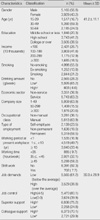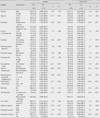1. Byun CB, Youn K, Jung-Choi K, Cho Y, Paek D. Depressive symptoms of workplace violence exposed subjects in Korea. Korean Journal of Occupational and Environmental Medicine. 2009. 21:314–323.
2. Carder M, Turner S, McNamee R, Agius R. Work-related mental ill-health and 'stress' in the UK (2002-05). Occupational Medicine. 2009. 1–6. (online published).
3. Chang SJ, Koh SB, Kang D, Kim SA, Kang MG, Lee CG. Developing an occupational stress scale for Korean employees. Korean Journal of Occupational and Environmental Medicine. 2005. 17:297–317.
4. Eriksen W, Tambs K, Knardahl S. Work factors and psychological distresses in nurses' aids: A prospective cohort study. BMC Public Health. 2006. 6:290.
5. Han IS, Kim SY, Cho YC. A study on the depression mood among textile industrial workers. Chungnam Medical Journal. 1995. 22:33–47.
7. Hoel H, Sparks K, Cooper CL. The cost of violence/stress at work and the benefits of a violence/stress-free working environment. 2001. Geneva: International Labour Organization.
8. Hong MJ. A study on nurses' experiences of violence. 2009. Daejeon: Eulji University;Unpublished master's thesis.
9. Ikeda T, Nakata A, Takahashi M, Hojou M, Haratani T, Nishikido N, et al. Correlates of depressive symptoms among workers in small- and medium-scale manufacturing enterprises in Japan. Journal of Occupational Health. 2009. 51:26–37.
10. Jung HY. A study on relationship among violence experience, coping and burnout of emergency department nurses. 2008. Busan: Inje University;Unpublished master's thesis.
11. Kamchuchat C, Chongsuvivatwong V, Oncheunjit S, Yip TW, Sangthong R. Workplace violence directed at nursing staff at a general hospital in Southern Thailand. Journal of Occupational Health. 2008. 50:201–207.
12. Kim JS, Shin KR. A study on depression, stress, and social support in adult women. Journal of Korean Academy of Nursing. 2004. 34:352–361.
13. Kim JY. Drinking, the standardization of data collections and measurements in health statistics. 2000. Seoul: Gyechukmunhwasa.
14. Kim SY, Ahn HY, Kim HS. Violence experiences of clinical nurses and nurse aids in hospitals. Korean Journal of Occupational Health Nursing. 2008. 17:76–85.
15. Kingma M. Workplace violence in the health sector: A problem of epidemic proportion. International Nursing Review. 2001. 48:129–230.
16. 2007 Korean Health Statistics. Ministry of health and welfare & Korea centers for disease control and prevention. 2009. 03. 19. Retrieved March 31, 2010. from
http://knhanes.cdc.go.kr/.
19. Lee WH, Kim CJ. The relationship between depression, perceived stress, fatigue and anger in clinical nurses. Journal of Korean Academy of Nursing. 2006. 36:925–932.
20. Morita N, Wada I. Job stress and mental health of child-counseling office workers. Journal of Occupational Health. 2007. 49:125–133.
22. Park J, Lee N. First Korean working conditions survey: A comparison between South Korean and EU countries. Industrial Health. 2009. 47:50–54.
23. Park JS, Lee GH, Kim JH. Report on Korean working conditions survey in 2006. 2007. Incheon: Occupational Safety and Health Research Institute, Korea Occupational Safety and Health Agency.
24. Park KC, Lee KJ, Park JB, Min KB, Lee KW. Association between occupational stress and depression, anxiety and stress symptoms white-collar male workers in an automotive company. Korean Journal of Occupational and Environmental Medicine. 2008. 20:215–224.
25. Pols RG, Hawks DV. "Is there a safe level of alcohol consumption for men and women" some progress. Drug and Alcohol Review. 1992. 11:339–342.
26. Song YH, GongYoo JO, Kim I, Choi W. The relationship between symptoms, job stress and intensity of labor among security firm workers. Korean Journal of Occupational and Environmental Medicine. 2008. 20:283–294.
27. Suwazono Y, Okubo Y, Kobayashi E, Kido T, Nogawa K. A follow-up study on the association of working conditions and lifestyles with the development of (perceived) mental symptoms in workers of a telecommunication enterprise. Occupational Medicine. 2003. 53:436–442.
28. US Department of Labor. National census of fatal occupational injuries in 2001. 2002. Washington DC: Author.
29. Wang JL, Lesaga A, Schmitz N, Drapeau A. The relationship between work stress and mental disorders in men and women: Findings from a population-based study. Journal of Epidemiology and Community Health. 2008. 62:42–47.
30. Wieclaw J, Agerbo E, Mortensen PB, Burr H, Tuchsen F, Bonde JP. Work related violence and threats and the risk of depression and stress disorder. Journal of Epidemiology and Community Health. 2006. 60:771–775.
31. World Health Organization. World report on violence and health. 2002. Geneva: Author.
32. Yoo YS, Na C, Lee KH. A correlative analysis between alcohol use and anxious or depressive trends among psychiatric inpatients. Chung-Ang Journal of Medicine. 1990. 15(2):97–113.







 PDF
PDF ePub
ePub Citation
Citation Print
Print



 XML Download
XML Download